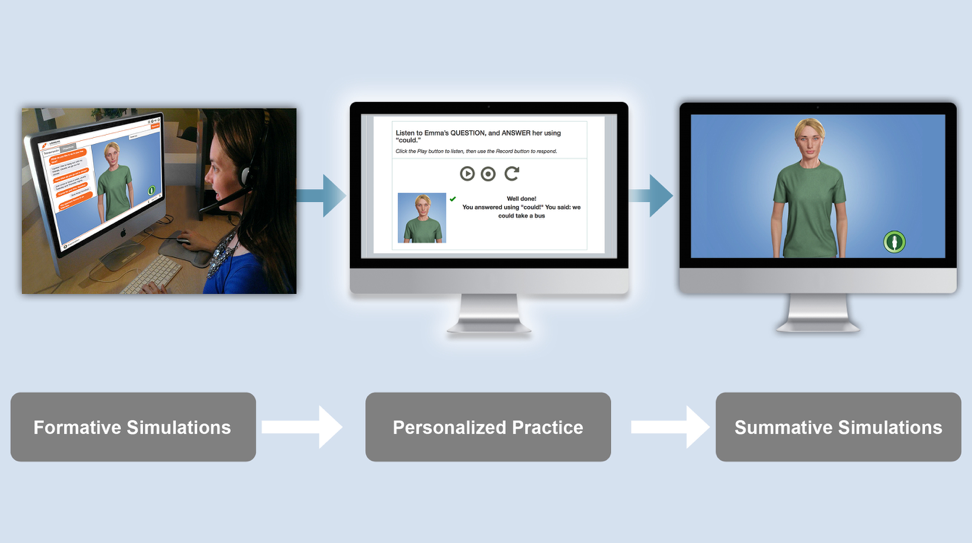If you are a teacher of English to speakers of other languages, you know how important it is for your students to practice speaking. The more they practice in authentic situations, the more confidence they will gain, and the more fluent they will become. Unfortunately this is not practical in the classroom, particularly in large classes. Even in classrooms with low student-teacher ratios, it is not feasible for a teacher to provide one-on-one practice with each student, much less provide personalized feedback. In EFL situations, the issue is further compounded by the lack of authentic scenarios outside the classroom.
Thanks to rapid developments in artificial intelligence (AI), learning tools are now available that solve this problem. Learners can practice speaking with AI-based avatars that simulate realistic conversations with native English speakers. They can gain fluency and build confidence through personalized practice anywhere, anytime, and get immediate feedback. Teachers can utilize classroom time for instruction instead of practice, while the software helps them track progress toward proficiency. The approach works regardless of the number of students in your class!
For example, instructors at a major university in Serbia are using Alelo’s AI-based Enskill® English — and English language teaching platform — to overcome the challenges of large class sizes. With 80 or more students in a class, it was virtually impossible for students to practice speaking in class. With Enskill, teachers now can ensure that students are getting the practice opportunities that they need. The Enskill avatars are infinitely patient; they give learners the opportunity to practice in a safe environment, without fear of being judged.

From the learner’s perspective, Enskill simulated conversations are natural and easy to use. Learners open up a Web browser and an animated avatar appears. They speak into a microphone and the avatar listens and responds. Instead of reading prompts off of a screen, learners are free to express themselves in their own words. The AI-based avatars are not following a script but respond appropriately to a variety of learner utterances. This gives learners the experience of conversing with native speakers who are accustomed to speaking with language learners, who speak naturally but in a manner that learners can understand.
Simulated conversations are designed with the end goal of spoken proficiency in mind. Each simulation is aligned with one or more can-do statements in the CEFR (Common European Framework of Reference), so that if the students master the conversation, they demonstrate that they can do what the can-do statements say they should be able to do. This turns can-do statements from subjective self-assessments into objective measures of proficiency.
Each simulation tests mastery of target language forms and vocabulary. They serve as formative assessments, automatically identifying which learning objectives the learner has failed to master. Students then receive personalized instruction on just those skills that learners need to improve. This accelerates progress toward mastery. The simulated conversations provide realistic and concrete contexts for learning, which aids in retention.
Teachers receive reports for each student that indicate how much time they have spent practicing, and how many learning objectives they have achieved. Students are evaluated not just on pronunciation accuracy, but on the combination of fluency, accuracy, and language complexity that are the hallmarks of spoken proficiency.
These capabilities stand in sharp contrast with previous language-learning technologies, where students engaged in mind-numbing drills of vocabulary, grammar, and pronunciation. A unique combination of advanced artificial intelligence technologies makes this breakthrough approach possible. Speech recognition and natural language processing are used to analyze and interpret what the student says, and scoring algorithms are used to evaluate and assess learner responses. Machine learning is used to build and train the underlying language models. Enskill continually collects speech recordings from language learners around the world. Alelo analyzes these recordings and uses them to improve the AI models.
Laureate International Universities, a network of educational institutions with a million students in 25 countries, is an example of a major institution where instructors are benefiting from Enskill English. Laureate provides Enskill to all of its English instructors around the world for use in their classes. They see it as being particularly important for online classes, where learners are studying on their own and get even less opportunity to practice with native English speakers.
Think of how this new technology could help you teach more effectively. Are you ready to incorporate AI into your program? Are you interested in the advantages that AI offers? Try it for yourself with a 3o-day free trial!



About The Author
Lewis Johnson
Dr. W. Lewis Johnson is President of Alelo and an internationally recognized expert in AI in education. He won DARPA’s Significant Technical Achievement Award and the I/ITSEC Serious Games Challenge, and was a finalist in XPRIZE Rapid Reskilling. He has been a past President of the International AI in Education Society, and was co-winner of the 2017 Autonomous Agents Influential Paper Award for his work in the field of pedagogical agents. He is regularly invited to speak at international conferences for distinguished organizations such as the National Science Foundation.